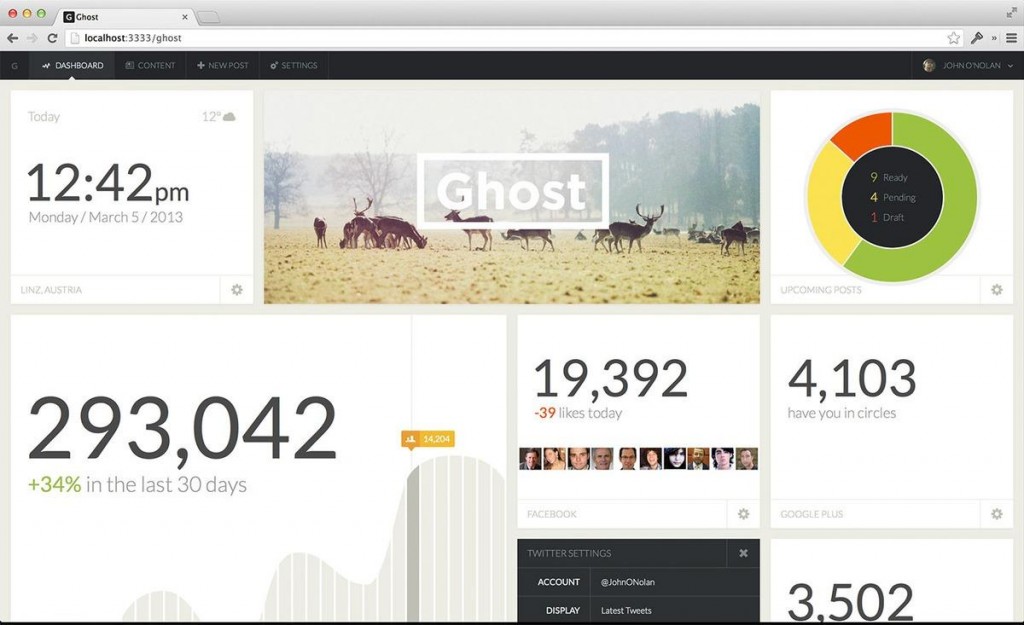Note from Editor: Although we write and share only about WordPress on JustWP.org, but the article from our guest author sounds encouraging to us to make it publish. The article talks about a project which was recently funded via Kickstarter dubbed as Ghost, non-profit and open-source blogging platform and lefts a question for you on what you think that does this platform will be the future of blogging in real or not?

In the present times, WordPress has sort of become synonymous with the self publishing and blogging industry. The impeccably feature rich blogging platform which just celebrated its 10 year anniversary recently has been customized to be used as the backend content management systems for various websites. The PHP and My SQL based development framework has undergone various revisions over the years and have now evolved as one of the leading blog publishing and website managing tools.
However, with every update and the revisions and the glorious additions to the existing CMS, the platform lost the nascent charm and innocence that it had as the quintessential blog publishing platform. Today, it competes with the likes of Drupal and Joomla etc and renders highly complex solutions to the website. But does it still have in itself the mantle to remain the top most blog publishing platform? With the introduction of the brand new Ghost platform and a kick starter campaign being right in its place to expedite the release of it, WordPress perhaps would want to pull up its socks and get ready for the competition.
Here is telling you all about the new platform, its features and how it might just take the ultimate blog publishing platform crown away from WordPress. Intrigued already? Discover more about the new platform below.
The Vision of an Extraordinary ex WP-Developer
For an avid WordPress fan, John O’Nolan is not just a designer or a developer; he is actually an extraordinary visionary who was actually the human force behind sustaining the WordPress platform for a long time, along with his colleagues of course. And now we have the same trustworthy soul backing up – actually initiating, implementing and taking the entire charge of this very new blogging platform. It was he who realized that WordPress has no longer remained a simple platform for the passionate bloggers to publish their content and so he embarked upon a self initiated crusade to develop a blogging platform which takes the focus back to the basics and bring the job back to the now monotonous and quite a technical world of blogging.
There are various features of this platform which are dedicated solely towards blogging and O’Nolan do not even intend to make this platform do anything more than that. So there will not be any backend website content management etc, the platform is going to support the plain, uber simple and classic blogging.
The dashboard that you would actually use
The current WordPress dashboard is too distracting and often we don’t even use most of its features. Now, Ghost provides a dashboard which is actually going to reduce the amount of backend work required and streamline all the processes. The dashboard of Ghost actually intends to tend to the pressing need of easy management.
The dashboard design is minimalistic, and allows the users to manage a host of activities, without getting lost in the myriad of tabs as it brings all the required information under one roof, which includes:
- Data and time
- New subscribers to your blog and subscriptions to social media
- The list of subscribers whose Circles include you
- The likes received by your blog
- Information regarding the performance of the content
- Documents which are ready, pending or saved as drafts and a lot more.

Marvelous Markdown Editor
Nothing kills the creativity and the chain of thoughts more than having to reach out to the mouse from the keyboard ever so often and perform manually all the required style changes, in order to better visualize the content. And then, let us not even talk about the backend editor of WordPress, which, with all due respect, is painfully boring.
With Markdown editor, you would not have to worry about the markup of the content, and would easily get to edit the content, and see its preview in the adjacent preview section. Thus even the minimally tech savvy person can easily pull up a fully edited, hyperlinked, and well organized content on their own, without any hassle.
A mobile App
The developers perhaps understand the fact that inspiration can hit you any minute and hence it has made available the mobile app to allow the users to draft and update the content even while they are sipping Mocha at Starbucks or taking a ferry ride back home. And yes, you still get to enjoy the markdown editor feature even if you go mobile.
Besides, the developers are really focused about the blog publishing. They plan for Ghost to run as a non-profit initiative and all the money that it would make would be used in further uplifting the platform. Although the popularity of WordPress is unshakable, this platform really appears to be a rather promising and inspiring blogging platform. Regardless of who wins the popularity votes, what it means to the bloggers is the advent of highly amazing features in these two platforms, for a sense of competition often inspires such a behavior. Let us know if you would like to try Ghost out and how excited you are about the same in the comments section below.





